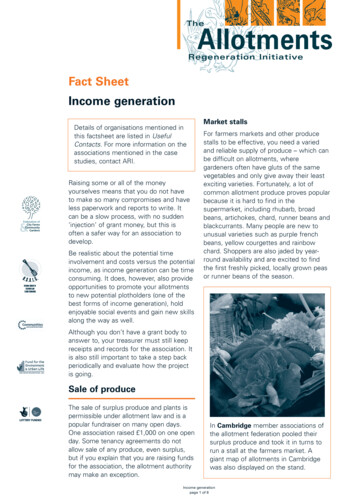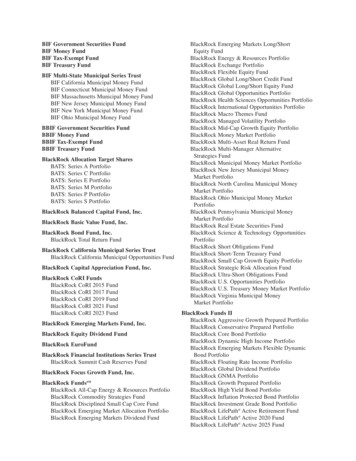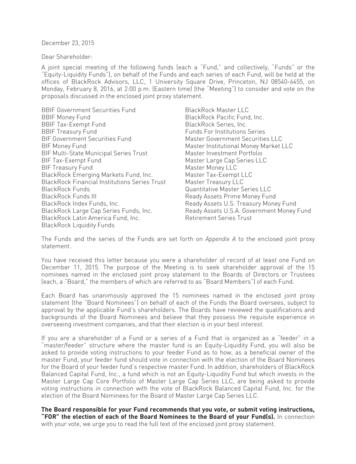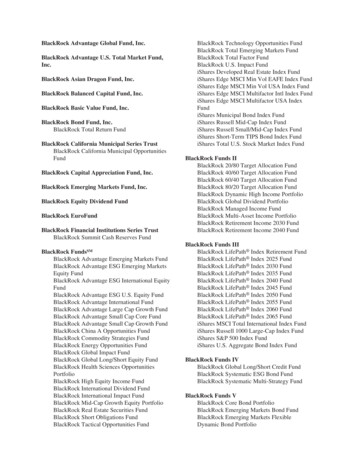
Transcription
TheAllotmentsRegeneration InitiativeFact SheetIncome generationDetails of organisations mentioned inthis factsheet are listed in UsefulContacts. For more information on theassociations mentioned in the casestudies, contact ARI.Raising some or all of the moneyyourselves means that you do not haveto make so many compromises and haveless paperwork and reports to write. Itcan be a slow process, with no sudden‘injection’ of grant money, but this isoften a safer way for an association todevelop.Be realistic about the potential timeinvolvement and costs versus the potentialincome, as income generation can be timeconsuming. It does, however, also provideopportunities to promote your allotmentsto new potential plotholders (one of thebest forms of income generation), holdenjoyable social events and gain new skillsalong the way as well.Market stallsFor farmers markets and other producestalls to be effective, you need a variedand reliable supply of produce – which canbe difficult on allotments, wheregardeners often have gluts of the samevegetables and only give away their leastexciting varieties. Fortunately, a lot ofcommon allotment produce proves popularbecause it is hard to find in thesupermarket, including rhubarb, broadbeans, artichokes, chard, runner beans andblackcurrants. Many people are new tounusual varieties such as purple frenchbeans, yellow courgettes and rainbowchard. Shoppers are also jaded by yearround availability and are excited to findthe first freshly picked, locally grown peasor runner beans of the season.Although you don’t have a grant body toanswer to, your treasurer must still keepreceipts and records for the association. Itis also still important to take a step backperiodically and evaluate how the projectis going.Sale of produceThe sale of surplus produce and plants ispermissible under allotment law and is apopular fundraiser on many open days.One association raised 1,000 on one openday. Some tenancy agreements do notallow sale of any produce, even surplus,but if you explain that you are raising fundsfor the association, the allotment authoritymay make an exception.In Cambridge member associations ofthe allotment federation pooled theirsurplus produce and took it in turns torun a stall at the farmers market. Agiant map of allotments in Cambridgewas also displayed on the stand.Income generationpage 1 of 8
Bullroyd Allotments Association,Bradford hold an open day every year.They can make up to 400 for theassociation by selling plants.Marketing ideas for stalls: Have a leaflet (a simple typed sheet isfine) to tell shoppers who you are, andhow and where they can get moreproduce. Provide recipe cards, especially forgluts or less common produce. Offer cooked ‘tasters’ from the recipesand invite customers to try these.Provide plastic spoons or samples oncream crackers. Display a map and photos of yourallotments or allotment sites acrossyour city. You could use map pins toindicate where the produce washarvested each week. Provide details of open days or otheropportunities for customers to visit anddetails of renting a plot.Someassociationshave found thata more low-keyapproach such asgoing to schoolfairs and otherlocal events towork better thanattendingestablishedmarkets. Oneassociationasked their localschool if theycould hold astand outside theschool whenparents were picking up children afterschool and raised considerable funds.‘Honesty box’ produce stallsThese are more familiar in the countrysidebut have also worked well in cities, as longas vandalism is not a serious problem inthe locality. Putting the stand insomeone’s garden can help to reducevandalism. Ensure the moneybox is firmlyfixed and emptied regularly and do notleave produce out overnight.Try to position the stand somewhere withgood ‘footfall’ (passer-bys) but where it isnot an obstruction, although if the stand iskept well stocked word will get round andpeople will travel to it.Statutory requirementsSelling produce and processed food cangenerate income but also brings addedresponsibility. Start planning well in advanceand ask your local council environmentalhealth and trading standards officers for aninformal ‘fact-finding’ meeting before youmake any firm plans. This way you canestablish which regulations you legally needto adhere to in a practical way, rather thanbeing restricted by them.Be aware of the following facts before youstart and think about the balance betweenhow much profit you will make comparedto how much effort and initial financialoutlay it will cost: All retailers selling food must registerwith their local environmental healthofficer. A basic food hygiene certificate isrequired if selling processed produce,e.g. jam or chutney. Expect to have yourpremises inspected by environmentalhealth. You may be required to registera home as a business. There are statutory requirements toadhere to regarding labelling, weightsand where you sell from. You may beable to overcome some tradingrestrictions by offering produce topeople for a suggested donation, ratherthan at a fixed price.If you are holding stalls regularly, marketswill require you to have Product Liabilityand Public Liability insurance. Therecommended minimum is 5 million.Some brokers offer a combined packagefrom under 100 per year.Sale of plants and related productsSpring plant sales are often popular forstock that cannot be obtained from gardencentres, e.g. vegetable seedlings.Income generationpage 2 of 8
One association asked each plotholderto grow 10 shrubs/bedding plants ontheir plot, for the yearly plant sale. Thesale raises an average of 300, withmost sales between plotholders andto parents passing from the nearbyprimary school. Provide photos of what the final plant/produce will look like. Provide growing instructions, e.g. on asticker on the pot. Unusual varieties of well-knownvegetables are popular, e.g. yellowcourgettes.Many common perennials are easy topropagate - a blackcurrant or gooseberrybush can provide 50 cuttings from theprunings alone, rhubarb crowns can bedivided and mint roots easily.Open days and other eventsOpen days can attract new plot holders,link with other people in the community,improve the site profile and raise funds inthe following ways: Have a ‘suggested donation’ entrancefee at the gate Charge stall holders a small fee orpercentage of their takings Charge a fee for special activities,e.g. craft workshops, garden tours,gardening workshops (it is better tooffer free entry if you do this)the entertainment over a whole day.The best form of publicity is word ofmouth, so make sure the plotholders havedetails far in advance. Announcements onlocal radio, listings in local papers, andposters and leaflets in local schools andshops work well too.Provide parking if you can, as localresidents will be irate if visitors take alltheir parking spots.Ideas for activities Social events - barbecues, harvestfestivals, picnics, games and treasurehunts are all popular. You could relateevents to the seasons. Avoid bonfirenights, which can damage the site andraise safety and insurance issues. Craft demonstrations - experiencedcraftspeople may be happy to providethese, espcecially if they are able to selltheir crafts, e.g. basketry, woolspinning, pole lathe turning, felt making.Find contacts through craft shows,markets and guilds. Crafts that usematerials harvested from the allotmentsmake a popular workshop ordemonstration. Ideas include basketsfrom brambles and climbers, making abread oven from garden clay, nettlestring, home brewed wine, woodturning using orchard wood on a footpedal-operated pole lathe. For moreinformation contact the PermacultureAssociation, look at back copies ofpermaculture magazines, or ‘selfsufficiency’ books. Raffles or prize competitions Produce and plant sales Sell refreshments.People will only want to come to theevent if there is a lot going on. It is betterto run a short event packed with activities,e.g. 2 – 4pm, rather than trying to drag outLancashire Wildlife TrustLinking to an existing national event is agood way of getting free publicity, e.g.National Gardens Scheme(www.ngs.org.uk), National AllotmentsWeekTM (www.nagtrust.org) or HeritageOpen Days(www.heritageopendays.org.uk).You could relate events to the seasons.Income generationpage 3 of 8
Practical gardening workshops orquestion panels - popular topics include101 ways to deal with slugs, fruitpruning and grafting, easy plantpropagation, easy vegetables and howto grow them, make and plant a herbhanging basket, how to build a compostbin, composting. Guided tours of the allotments - selectthe tour guide carefully: your visitorswill love anecdotes, gardeningknowledge and history of the site, butwill lose interest if the guide talksincessantly or if the tour is longer thanhalf an hour. Volunteers shouldaccompany the tour to ensure thatvisitors stick to paths and don’t wanderonto plots, so that the guide canconcentrate on giving the tour. Garden competitions and shows always popular, especially if theyfeature giant vegetables or vegetablecarvings or sculptures. Children’s activities - there are manygood books available on willow andnature crafts, face painting andgardening projects, so perhapssomeone in your group could run thechildren’s area. To avoid any problems,put a notice up stating that onlychildren accompanied by an adult cantake part. Refreshments - the traditional cup oftea and slice of cake works best. Offercold drinks too. Stalls - the more variety the better. Visitcraft and produce markets and localfairs to canvass potential stallholders. Music or theatre - from the local schoolchoir or the amateur theatrical group.Background music is more popular thanBeacon Hill Allotment and LeisureGardeners Society opens their site tothe public in September to coincidewith Lincolnshire Heritage Open Day.They link in with activities beingorganised by the local astronomicalsociety, which has their observatoryon site, and with the local historysociety which arranges visits to thecemetery next door with its BronzeAge burial mound. Because there is alot of activity going on they can attractas many as 250 people to the openday, and raise over 100 by sellingproduce.Moulsecoomb Forest Garden andWildlife Project holds cookingdemonstrations with a difference. Theyorganise pick and cook days, wherevisitors pick vegetables and fruit fromthe project’s plot of unusual and heritagevarieties, and a community cook is hiredto prepare and cook them on siteThey also link into the annual BrightonFestival Fringe, running an eventwhich includes music, storytelling anddressing up, nature trails and bughunts, and pizzas from the outdoorclay oven.Walnut Avenue AllotmentAssociation, Bury organises anumber of community events -including bonfires, barbecues, first aidcourses, and cook and eat sessions.loud bands, which deter people fromvisiting stalls or taking part in activities. Bees - every county has a beekeepersassociation, where you can find detailsof beekeepers with a glass-fronted hivethey can bring to events, a popularattraction for all ages.Social enterpriseDuring periods of low demand forallotments, your allotment authority mayconsider allowing you to use derelict plotsfor dedicated income generation if theprofits are solely for association purposes.These plots will require a ‘temporarychange of use’ under allotments law asIncome generationpage 4 of 8
they will no longer be used as allotmentsand must be genuinely surplus torequirements. The National Society ofAllotment and Leisure Gardeners(NSALG) can provide legal advice onthe Allotments Acts.Do not embark on activities that requirea permanent change of use on statutoryallotments, as this will make theallotment land vulnerable to development.Lawrence Weston AllotmentAssociation, Bristol has planted anarea of willow on some unused sites.The willow is used by all the plotholders for sticks and structures ontheir own plots. The surplus is used bythe local city farm. The farm sellswillow sticks and willow products andgives part of the profit back to theassociation.Growing ‘cash crops’ is often made tosound easier and more lucrative than it isin practice. Research your marketthoroughly and be confident that you willbe able to sell the product before you buystock and start planting. Find a trainingcourse or read technical publications ongrowing that particular crop, so you areaware of pitfalls and reasons for potentialcrop failure before you start.TWIGS (Therapeutic Work inGardening in Swindon) grow trays ofwheat grass in their polytunnel, whichthey sell for 3 each, to a gym cafe.Wheat grass is quick and easy to growfor making a highly nutritious juice:one Bristol juice bar sells wheatgrassat 10 a tray. See ‘The WheatgrassBook’, by Ann Wigmore for furtherinformation.The Permaculture Association produce amonthly magazine which often has incomegeneration ideas from gardening andrelated activities. You could also consultKitchen Garden magazine and smallholdingmagazines.TWIGS also prepare miniature herbgardens in hanging baskets, whichthey sell to a garden centre for 8TWIGSWillowContrary to popular belief, willow does nothave to be grown in a wet area, althoughit will grow well in waterlogged areasunsuitable for allotment use. It doesrequire good light levels, effective weedcontrol and prefers a fertile soil.Avoid the fast growing ‘biomass’ varieties,opt for coloured basketry ones instead.‘Contorted’ willow is popular as anornamental shrub and in flower arranging.Willow can be cropped after your firstyear. The plants will crop for decades.You could sell willow bundles or cuttingsat craft shows, garden shows or markets,or direct to florists. Coloured andIncome generationpage 5 of 8
‘contorted’ willow cuttings are useful asornamental or hedging plants and to make‘living willow’ fences.For information on growing willow and toorder cuttings, visit:www.thewillowbank.comTo find contacts of basket makers in yourarea, visit: www.basketassoc.orgOther potential cash crops: Hazel and dogwood coppice -- toproduce sustainable pea and beanpolesfor gardeners, for wattlework andweaving. After coppicing, dogwoodproduces attractive red shoots suitablefor basketry and other rustic weavingwork. Ideal for shady plots unsuitableWindmill Hill City Farm, Bristolmanufactures comfrey liquid feed andsells it to visitors for 5 for a two litrebottle (2010 price). Comfrey liquid feedhas a similar nutrient composition tomany commercial liquid feeds and isparticularly suitable for tomatoes andother fruiting plants, due to its highpotassium content.It is very simple to make: take a barrelor tub, cram with comfrey leaves, fillwith water and leave for 3 to 5 weeks.Don't be put off by the smell - it'sgood stuff! Ladle into plastic bottlesand label clearly. Nettles and seaweedcan be added to the comfrey leaves toenhance nutritional composition.To purchase comfrey visit:www.organiccatalog.comFor more information about comfreycontact Garden Organic or see BobFlowerdew’s ‘The Organic Bible’ orany other good organic gardeningbook.for food production. Visit:www.allotmentforestry.co.uk for moreinformation and a list of suppliers.Please note: permission from theallotment authority for statutory sites isessential. Asparagus - start-up costs are high andasparagus pests, e.g. asparagus beetle,are often common on allotments. Strawberries can offer a lucrative yield,if kept weed and slug free. Tree nurseries for unusual fruit and nuttrees and shrubs. Visit:www.agroforestry.co.ukOther fundraising ideasIf you are providing a service, such asgardening, it is important to be reliable andprofessional, regardless of it being afundraiser for your association.Allotments are photogenic places, withallotment holders, sheds and produceproviding plenty of scope for calendars,greetings cards and so on. You will needto be confident that you have a market forthese (especially since charity calendarshave become so popular), and dry storage.You could approach local businesses forsponsorship (e.g. by paying for printing) inexchange for displaying their logo onpromotional information.Hold a charity dinner, using allotmentproduce for the meal and flowers todecorate the venue. Publicise the event tosympathetic local councillors, businessesetc, as well as plotholders. ‘Safari’suppers, where guests travel to a differentvenue for each course are very popular,often raising over 1,000 per event.Providing products and services that areuseful to plotholders is the easiest way ofcreating a market for your product, e.g.willow wigwams for climbing beans,refurbished tools and plot clearanceservices.Trading HutsMost allotment sites are now full and withthe increase in ‘Grow Your Own’ generallythere is an increased market of willingbuyers for trading huts to entice. The keyIncome generationpage 6 of 8
The viability of a site trading hut candepend on a number of factors: how muchcompetition there is from existing tradingBeacon Hill Allotment and LeisureGardeners Society, Cleethorpes hasa table by their store for plot holdersto leave surplus plants and produce.They are also encouraged to recycleany unwanted gardening tools here. Adonation box is left out for people tomake contributions for whatever theytake away.A well-stocked and well-presented tradinghuthuts on other sites in your area; theamount of willing volunteers you have torun the hut; whether you already have asuitable building or storage container totrade from.What you will need:Walnut Avenue AllotmentAssociation, Bury has a communalbuilding on-site with a meeting room,cooking facilities and toilets. They hireout the community building to tenantsand residents associations, localcouncillors to run surgeries andcommunity groups. The money raisedgoes towards paying for the runningcosts of the building. They also have acraft centre where they make birdboxes and bat boxes for sale. Permission from the allotment authorityand/or council. You may be able to sellto members of the public if theybecome associate members of theassociation.May Lane Allotments, Birminghamhas been holding a series offundraisers to contribute to a new rooffor their pavilion. They have organisedEaster egg hunts, quizzes, raffles andbarbecues on site. A business loan, sponsorship or a smallbusiness ‘start up’ grant to financepurchasing of the building (if notCole Park Allotments, Twickenhamhas, in agreement with their localcouncil, rented out a small number ofcar parking spaces when there arerugby matches at nearby Twickenhamrugby ground. This provides a smallregular income for the association andreduces traffic congestion.Sefton Park Allotments, Liverpoolraises about 600 per year byrecycling paper and cardboard on theirsite. They collect about six skip loadsper year from site members. This is ascheme that has been funded by thelocal council. A secure building, e.g. a metal shippingcontainer. The container must beremovable to avoid onerous planningconditions. Product liability, as well as public liabilityinsuranceBullroyd Allotments Association,Bradford makes a small amount ofmoney for the association by buyingseeds through a discount scheme,saving more than 20% on the cost ofseeds. The money they save isenough to buy fuel for theassociation’s power tools.Walnut Avenue AllotmentAssociation, Bury has a trading shopon site which sells garden supplies,bedding plants and compost. They buylarge 25 kg bags of compost whichthey then re-bag into 1 kg bags to sell.The shop raises about 600 per year,which pays for organising and runningthe annual flower show.Income generationpage 7 of 8Ascott Allotments, Ealing, Londonto obtaining as wide a market as possibleis to obtain permission from the allotmentauthority to allow ‘Associate Membership’of the trading hut as this permitsmembers of the public to purchase fromthe hut.
donated) and the initial outlay ofstock. Charitable grants cannot beused for a commercial venture.Our vision is toincrease allotmentuptake by individualsand groupsContact ARI at:The GreenHouseHereford StreetBristol BS3 4NA A survey of plot holders to gaugewhich materials to buy and in whatquantities. Compare the prices ofdifferent horticultural wholesalers.Placing orders with neighbouringsite shops may reduce orderingcosts. NSALG provides a discount seedscheme to its members. A trading hut brings additionalresponsibilities – see ARI packHealth and Safety on Allotments –A Management Guide.Tel: 0117 963 1551Fax: 0117 923 CommemorationAllotment gardening is a popularhobby with older people, oftenenabling them to enjoy a healthy,sociable and independent old age.Invite plotholders to consider theallotments in their will or covenant, asa way of ensuring that futuregenerations can continue to enjoyallotments.Some associations provide theflowers for a deceased gardener’sfuneral from their plots, a morepersonal touch than florists bouquets,with friends and relatives making adonation to the allotments instead ofbuying flowers.Other income fromplotholdersRent and servicesConsider charging for other additionalservices, e.g. plot clearance, rotovatoruse, a plot with a shed. Carry out bulkcollection of manure/leafmould andcharge per barrow.Printed on re-cycled paperMJT Design 0117 977 5746The water bill is often an association’sbiggest cost. Consider levying aseparate water charge from tenants,to encourage water conservation.Provide information on waterconservation measures such asmulching and correct watering andhow to report a burst or leaking waterpipe.Mudchute Allotments, Londonhave a memorial garden as a placefor plotholders to relax andremember deceased fellowgardeners. Memorial gardens canoffer relatives and friends thechance to make a donation totheir deceased relative’s favouritehobby through a commemorationbench, plaque or tree.Produced by FCFCG on behalf of ARIPlease feelfree tophotocopy andcirculate ARIpublicationsProviding even basic services on anallotment site is not cheap andallotments are just one of countlesscouncil services vying for subsidy.None of us want to pay more than wecan afford for our plot rental butpaying a bit more can be a good wayof bringing the site up to scratch.October 2011This factsheetis alsoavailableinlargeprint,brailleor onaudiotapefrom theARIofficeDevolved (self) management allowsyour association to set the plot rentalrate and decide how rental income isspent.Income generationpage 8 of 8
pedal-operated pole lathe. For more information contact the Permaculture Association, look at back copies of permaculture magazines, or ‘self sufficiency’ books. One association asked each plotholder to grow 10 shrubs/bedding plants on their plot, for the yearly plant sale. The sa










